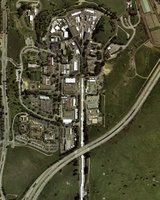SLAC
 The trusted peers took a tour of SLAC, the Stanford Linear Accelerator. With a bit of luck, some unusual events and his French charm, Emmanuel arranged for Neil Calder, a Scot from Islay and the current Director of Communications, to show us around. Neil’s passion for science is infectious and his gift for explaining the complex in simple terms had us all ready to go back to school to study physics.
The trusted peers took a tour of SLAC, the Stanford Linear Accelerator. With a bit of luck, some unusual events and his French charm, Emmanuel arranged for Neil Calder, a Scot from Islay and the current Director of Communications, to show us around. Neil’s passion for science is infectious and his gift for explaining the complex in simple terms had us all ready to go back to school to study physics.This was my first visit to SLAC, a great irony given the number of years I have spent in close proximity to the Stanford / Department of Energy facility. I’m fascinated by particle physics and I was aware of the ground-breaking research conducted at the linac, but I thought that there wouldn’t be much to see. It turns out I was wrong.
The tour began with a drive to the Klystron gallery. Klystrons (top left) are machines that pump energy into the electrons and positrons as they travel down the accelerator. The Klystrons are above ground in a 2 mile long building (the world’s straightest and longest) that spans much of the 430 acre SLAC campus. The particles they energize travel in the beamline 30 feet below ground.
 From the Klystron gallery we drove by end stations A and B, the site of the discovery of the Charm Quark and the tau lepton. Then we visited the Stanford Large Detector (top right), a six-story tall collision point for positrons and electrons that travel down the main beamline.
From the Klystron gallery we drove by end stations A and B, the site of the discovery of the Charm Quark and the tau lepton. Then we visited the Stanford Large Detector (top right), a six-story tall collision point for positrons and electrons that travel down the main beamline.Neil was justifiablely proud of the particle research that has been conducted at Stanford. Work at SLAC led to Nobel prizes in 1976, 1990 and 1995. And, SLAC’s B-factory is playing a critical role in the BaBar project to try to determine what happened to all of the anti-particles created by the Big Bang.
However, what was most impressive about our tour guide was his enthusiasm for the groundbreaking work yet to come. Although new particle discovery now requires more powerful accelerators than can be built at Stanford, SLAC physicists remain at the forefront of their field in design of next generation accelerators (specifically the ILC), in the creation of new devices for particle astrophysics research, and in developing new applications for existing facilities.
To illustrate the last point, Neil took us to the Stanford Synchrotron Radiation Laboratory (SSRL) and showed off SPEAR3 (photos bottom). For particle physics work, synchrotrons have the undesirable quality that they leak energy in the form of x-rays. For solid-state physics, material science, structural biology and chemistry, it turns out this is very good as the bright, intense light enables scientists to see structures at the atomic and nano scales.
To give us a greater sense for the future of SLAC, Neil described the Linac Coherent Light Source (LCLS). SLAC scientists have devised a way to create a beam of 1 trillion tightly focused x-rays that will pulse at femtosecond intervals. When the $380 million project is completed in 2009, the result will be revolutionary technology to capture atoms and biological processes in real-time.
When we finished our tour, we couldn’t stop commenting how much fun our visit had been. Our thanks to Neil for his very valuable time and to his department for their efforts at comunity outreach. If you haven't been to SLAC, register for a tour. It is not only my cool thing of the day; it was one of the coolest things of the year.
Bonus link: more pictures from our visit

1 Comments:
Great post Paul. It makes me want to go see it again!
Post a Comment
<< Main page